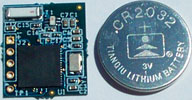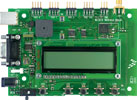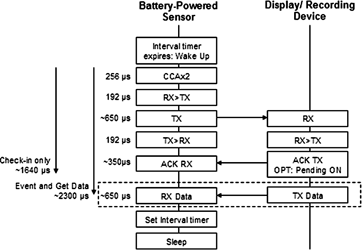
IEEE 802.15.4 has made choosing a simple, cost-effective, standards-based wireless solution for a remote sensor or control element easy. Previously, remoting a sensor, whether in a building or residence, a farmer's field, or even on the human body, required either running wires or home-brewing a wireless solution that distracted from the effort required to engineer the product itself. Now, with second-generation IEEE 802.15.4 platforms from Freescale Semiconductor and other manufacturers, adding standards-based wireless to a product is easy.
The initial IEEE 802.15.4 was ratified in May 2003 as the first low-rate (250 Kbps max), low-power (nominally -3 dBm transmitter output power), envisioned for applications that could live off of primary batteries (Li, alkaline) for months to years. Range under practical conditions varies from 10-40 m indoors to hundreds of metres outside. For specific, low-power sensor applications married to AA or AAA alkaline cells, it is practical to design products that can outlive the battery's shelf-life. In addition to its native energy efficiency, it is proven to be equally gentle on the designer's bank account, with current generation product prices already below Bluetooth in the same quantities.
Figure 1 shows a complete, 2,4 GHz MC1321x single-chip transceiver/MCU, including 16 MHz crystal and chip antenna, as a module that is nearly the same size as a typical lithium coin cell. Paired with one of Freescale's accelerometers, pressure, or pressure/temperature sensors, it allows the designer to quickly and easily put sensors wherever they are required, with little impact on the final product's overall size and cost.

Development kits such as the 13213NCB (Figure 2) provide a wealth of I/O functions, like switches, LEDs, 10-bit ADCs, digital I/O pins, integrated sensors, and serial or USB connectivity, as well as software that makes it very straightforward to quickly design sophisticated sensor functionality with integrated standards-based wireless.

IEEE 802.15.4 is a two-way wireless technology, with four packet types defined in the standard. The two most important packet types for most scenarios are the Data and Acknowledgement packets. The station sending the data uses the 'Data' packet, and expects to receive in return, an 'Acknowledgement' packet indicating that the receiving station has indeed received the packet without error. Typical two-way transmission times (see Figure 3) are in the 2 to 3 ms range, allowing the clever designer to substantially improve battery life by shutting down the radio, MCU, sensor and support circuitry when not needed. This accelerometer provides stable data as soon as 1000 μs after power-up, and given the low power consumption (500 μA it is easiest to leave on the sensor and shut down the MCU between measurements. A third packet type, called the Beacon packet, can provide even lower power consumption for completely battery-operated networks such as agricultural sensors strewn across a field. Sensors using the 'beacon mode' know a priori when their neighbours will be listening, so they do not waste transmitter or receiver power trying at other times. In this mode, power consumption is optimised at some expense of latency.

As a simple example, the effort required to build a wireless, 3-axis accelerometer that could fit within the confines of a gaming glove or running shoe, requires only the MC1321x part, and the MMA7260Q 3-axis accelerometer can be quickly paired along with three chip resistors and four chip capacitors, to create the completed wireless sensor.
Example
In the running shoe scenario, there is a need to know the acceleration peaks as well as the foot's pronation (tilt inward or outward) when it hits the pavement. This means that while in operation, both the sensor and the MCU must be active for about 100 μs every millisecond for smooth measurements. However, the radio needs to only come on once every hundred milliseconds to transmit the data collected wirelessly to the data display and collection device on the runner's wrist or coach's handheld computer. Running data, including pronation, elastic rebound, stride, speed and rate, can all be accurately measured and reported back to the runner in realtime, allowing them to better understand their performance and how to improve it. The sensor pulls less than 500 μA in operating mode and only 3 μA in sleep mode, in-between readings. The MCU draws 5-10 mA depending on the computational speed required, and in sleep, powers down to only a few microamps, with a deep-sleep mode well under a microamp. Under normal operating conditions defined by the user, the radio needs to transmit packets at a 0,1 to 10 Hz rate - otherwise, the radio is powered down. Average current draw averages only 5-10 mA during operation, and when the shoe is put away for the day, cycles down to a few microamps, saving the batteries for another day of running. Depending on the battery capacity and usage patterns, a single CR2032 coin cell can provide detailed telemetry for up to 40 hours of non-stop running, while adding less than 30 g of mass to the shoe. For some people, that 40 hours could outlive the life of the shoe!
Conclusion
While this example may be more extreme than the device that the developer needs to build, it demonstrates how easy it is to add standards-based, simple wireless to an existing or 'on the drawing board' product. With silicon from multiple vendors, and the protocol and qualifications all taken care of by the silicon platform vendor, the developer can now spend their time worrying about the final product's form, fit and function, rather than how to transfer the information generated. And when the application needs tight integration with sensors and control devices, Freescale's wireless technology, silicon sensors and embedded processing and control means a one-stop-shop for the developer.
| Tel: | +27 11 923 9600 |
| Email: | [email protected] |
| www: | www.altronarrow.com |
| Articles: | More information and articles about Altron Arrow |
| Tel: | +27 11 236 1900 |
| Email: | [email protected] |
| www: | www.ebv.com |
| Articles: | More information and articles about EBV Electrolink |

© Technews Publishing (Pty) Ltd | All Rights Reserved